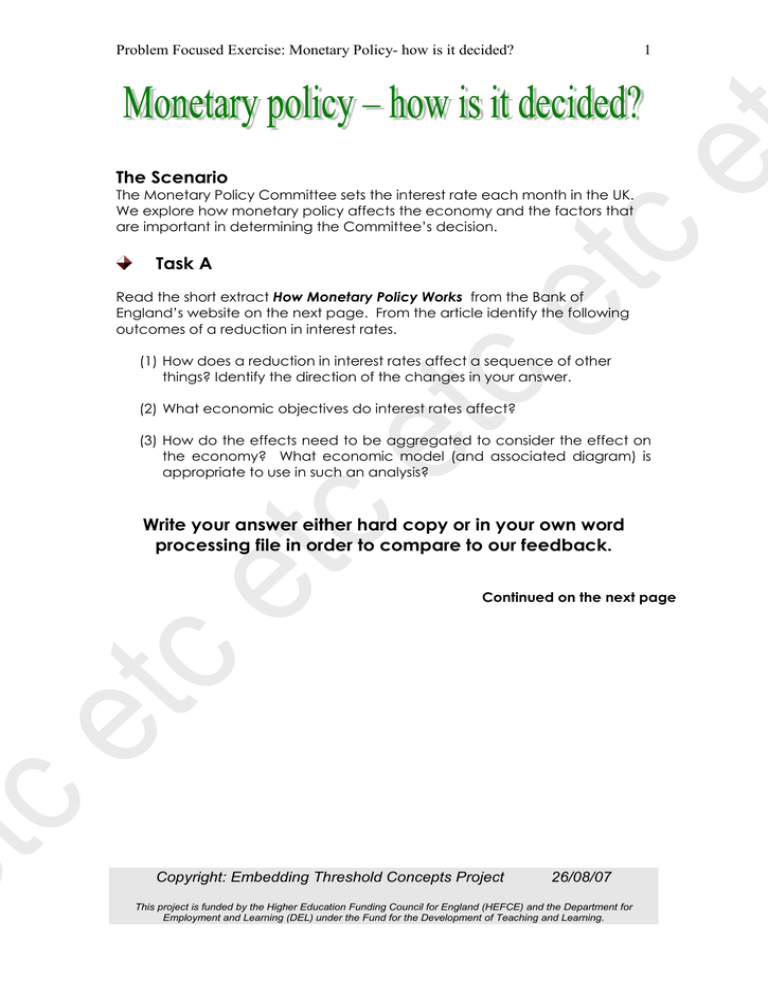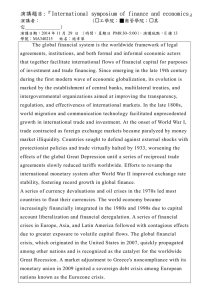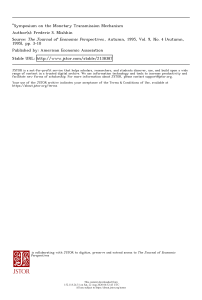The Scenario Problem Focused Exercise: Monetary Policy- how is it decided? 1
advertisement

Problem Focused Exercise: Monetary Policy- how is it decided? 1 The Scenario The Monetary Policy Committee sets the interest rate each month in the UK. We explore how monetary policy affects the economy and the factors that are important in determining the Committee’s decision. Task A Read the short extract How Monetary Policy Works from the Bank of England’s website on the next page. From the article identify the following outcomes of a reduction in interest rates. (1) How does a reduction in interest rates affect a sequence of other things? Identify the direction of the changes in your answer. (2) What economic objectives do interest rates affect? (3) How do the effects need to be aggregated to consider the effect on the economy? What economic model (and associated diagram) is appropriate to use in such an analysis? Write your answer either hard copy or in your own word processing file in order to compare to our feedback. Continued on the next page Copyright: Embedding Threshold Concepts Project 26/08/07 This project is funded by the Higher Education Funding Council for England (HEFCE) and the Department for Employment and Learning (DEL) under the Fund for the Development of Teaching and Learning. Problem Focused Exercise: Monetary Policy- how is it decided? How Monetary Policy Works 2 From interest rates to inflation A reduction in interest rates makes saving less attractive and borrowing more attractive, which stimulates spending. Lower interest rates can affect consumers’ and firms’ cash-flow – a fall in interest rates reduces the income from savings and the interest payments due on loans. Borrowers tend to spend more of any extra money they have than lenders, so the net effect of lower interest rates through this cash-flow channel is to encourage higher spending in aggregate. The opposite occurs when interest rates are increased. Lower interest rates can boost the prices of assets such as shares and houses. Higher house prices enable existing home owners to extend their mortgages in order to finance higher consumption. Higher share prices raise households’ wealth and can increase their willingness to spend. Changes in interest rates can also affect the exchange rate. An unexpected rise in the rate of interest in the UK relative to overseas would give investors a higher return on UK assets relative to their foreign-currency equivalents, tending to make sterling assets more attractive. That should raise the value of sterling, reduce the price of imports, and reduce demand for UK goods and services abroad. However, the impact of interest rates on the exchange rate is, unfortunately, seldom that predictable. Changes in spending feed through into output and, in turn, into employment. That can affect wage costs by changing the relative balance of demand and supply for workers. But it also influences wage bargainers’ expectations of inflation – an important consideration for the eventual settlement. The impact on output and wages feeds through to producers’ costs and prices, and eventually consumer prices. http://www.bankofengland.co.uk/monetarypolicy/how.htm Basic Feedback Intermediate Feedback Copyright: Embedding Threshold Concepts Project 26/08/07 This project is funded by the Higher Education Funding Council for England (HEFCE) and the Department for Employment and Learning (DEL) under the Fund for the Development of Teaching and Learning.







